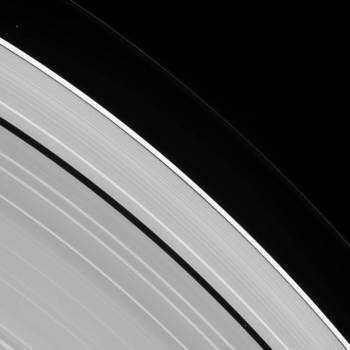2016.10.04:土星の2つの小さな衛星 [NASA]
NASAの土星探査機カッシーニの最新画像は2つの衛星パンとアトラスが写った画像です。
衛星がどこにあるかおわかりなりますでしょうか?
アメリカ人はこういうの好きですね。

答えはこちら:土星の2つの小さな衛星
アンチエイジングプラス30パッチ (Anti-Aging Plus) 【パッチMD社製】
オリジナル記事:
Two Tiny Moons
“
Two tiny moons of Saturn, almost lost amid the planet’s enormous rings, are seen orbiting in this image. Pan, visible within the Encke Gap near lower-right, is in the process of overtaking the slower Atlas, visible at upper-left.
All orbiting bodies, large and small, follow the same basic rules. In this case, Pan (17 miles or 28 kilometers across) orbits closer to Saturn than Atlas (19 miles or 30 kilometers across). According to the rules of planetary motion deduced by Johannes Kepler over 400 years ago, Pan orbits the planet faster than Atlas does.
This view looks toward the sunlit side of the rings from about 39 degrees above the ring plane. The image was taken in visible light with the Cassini spacecraft narrow-angle camera on July 9, 2016.
The view was acquired at a distance of approximately 3.4 million miles (5.5 million kilometers) from Atlas and at a Sun-Atlas-spacecraft, or phase, angle of 71 degrees. Image scale is 21 miles (33 kilometers) per pixel.
The Cassini mission is a cooperative project of NASA, ESA (the European Space Agency) and the Italian Space Agency. The Jet Propulsion Laboratory, a division of the California Institute of Technology in Pasadena, manages the mission for NASA’s Science Mission Directorate, Washington. The Cassini orbiter and its two onboard cameras were designed, developed and assembled at JPL. The imaging operations center is based at the Space Science Institute in Boulder, Colorado.
For more information about the Cassini-Huygens mission visit http://saturn.jpl.nasa.gov and http://www.nasa.gov/cassini. The Cassini imaging team homepage is at http://ciclops.org.
Image Credit: NASA/JPL-Caltech/Space Science Institute
Last Updated: Oct. 3, 2016
Editor: Tony Greicius
日本語訳:
土星の小さな2つの衛星が、この画像の巨大な土星の環の中で、ほとんどわからないくらいで写っています。パンが右下のエンケ間隙の間に、左上にいるアトラスを追い越すようにして写っています。
全ての軌道上の物体は、大きくとも小さくとも基本的なルールに従っています。
この場合、パン(直径17マイルまたは28キロ)はアトラス(直径19マイルまたは30キロ)よりも土星に近い軌道にあります。そのルールに従うと、 400年以上前のヨハネス・ケプラーによる惑星運動の法則によりパンがアトラスよりも速い速度で地球を周回します。
この画像は、土星の環の平面の太陽に照らされた側から約39度上部より見たものです。2016年7月9日に探査機カッシーニの狭角カメラにより可視光で撮影されました。
この画像は、アトラスから約340万マイル(550万キロ)の距離で、太陽とアトラスとカッシーニの位相が71度の角度で撮影されました。画像解像度はピクセル当たり21マイル(33キロ)です。
カッシーニのミッションは、NASA、ESA(欧州宇宙機関)とイタリア宇宙機関の共同プロジェクトです。パサデナのカリフォルニア工科大学の部門であるジェット推進研究所は、ワシントンのNASAの科学ミッション本部のためにミッションを管理します。カッシーニ探査機と2つの搭載カメラは、設計、開発および組み立てをJPLで担当しました。イメージングオペレーションセンターは、コロラド州ボールダーの宇宙科学研究所にあります。
レチンAジェネリック0.1%(Acnelyse)
スポンサーリンク
衛星がどこにあるかおわかりなりますでしょうか?
アメリカ人はこういうの好きですね。

答えはこちら:土星の2つの小さな衛星
アンチエイジングプラス30パッチ (Anti-Aging Plus) 【パッチMD社製】
オリジナル記事:
Two Tiny Moons
“
Two tiny moons of Saturn, almost lost amid the planet’s enormous rings, are seen orbiting in this image. Pan, visible within the Encke Gap near lower-right, is in the process of overtaking the slower Atlas, visible at upper-left.
All orbiting bodies, large and small, follow the same basic rules. In this case, Pan (17 miles or 28 kilometers across) orbits closer to Saturn than Atlas (19 miles or 30 kilometers across). According to the rules of planetary motion deduced by Johannes Kepler over 400 years ago, Pan orbits the planet faster than Atlas does.
This view looks toward the sunlit side of the rings from about 39 degrees above the ring plane. The image was taken in visible light with the Cassini spacecraft narrow-angle camera on July 9, 2016.
The view was acquired at a distance of approximately 3.4 million miles (5.5 million kilometers) from Atlas and at a Sun-Atlas-spacecraft, or phase, angle of 71 degrees. Image scale is 21 miles (33 kilometers) per pixel.
The Cassini mission is a cooperative project of NASA, ESA (the European Space Agency) and the Italian Space Agency. The Jet Propulsion Laboratory, a division of the California Institute of Technology in Pasadena, manages the mission for NASA’s Science Mission Directorate, Washington. The Cassini orbiter and its two onboard cameras were designed, developed and assembled at JPL. The imaging operations center is based at the Space Science Institute in Boulder, Colorado.
For more information about the Cassini-Huygens mission visit http://saturn.jpl.nasa.gov and http://www.nasa.gov/cassini. The Cassini imaging team homepage is at http://ciclops.org.
Image Credit: NASA/JPL-Caltech/Space Science Institute
Last Updated: Oct. 3, 2016
Editor: Tony Greicius
日本語訳:
土星の小さな2つの衛星が、この画像の巨大な土星の環の中で、ほとんどわからないくらいで写っています。パンが右下のエンケ間隙の間に、左上にいるアトラスを追い越すようにして写っています。
全ての軌道上の物体は、大きくとも小さくとも基本的なルールに従っています。
この場合、パン(直径17マイルまたは28キロ)はアトラス(直径19マイルまたは30キロ)よりも土星に近い軌道にあります。そのルールに従うと、 400年以上前のヨハネス・ケプラーによる惑星運動の法則によりパンがアトラスよりも速い速度で地球を周回します。
この画像は、土星の環の平面の太陽に照らされた側から約39度上部より見たものです。2016年7月9日に探査機カッシーニの狭角カメラにより可視光で撮影されました。
この画像は、アトラスから約340万マイル(550万キロ)の距離で、太陽とアトラスとカッシーニの位相が71度の角度で撮影されました。画像解像度はピクセル当たり21マイル(33キロ)です。
カッシーニのミッションは、NASA、ESA(欧州宇宙機関)とイタリア宇宙機関の共同プロジェクトです。パサデナのカリフォルニア工科大学の部門であるジェット推進研究所は、ワシントンのNASAの科学ミッション本部のためにミッションを管理します。カッシーニ探査機と2つの搭載カメラは、設計、開発および組み立てをJPLで担当しました。イメージングオペレーションセンターは、コロラド州ボールダーの宇宙科学研究所にあります。
レチンAジェネリック0.1%(Acnelyse)
スポンサーリンク



